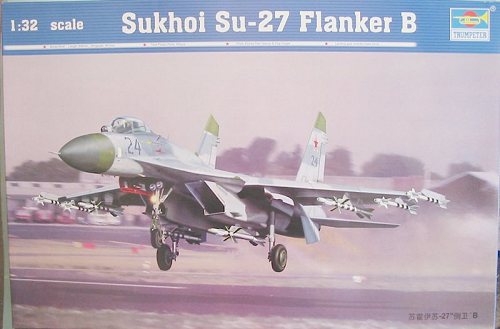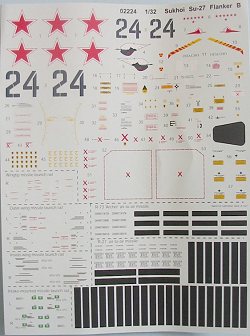
| KIT: | Trumpeter 1/32 Su-27 'Flanker B' |
| KIT #: | 02224 |
| PRICE: | $139.95 MSRP |
| DECALS: | One option |
| REVIEWER: | Tom Cleaver |
| NOTES: | Mortgage your house for the add-on room to display this monster! It’s biiiiiiig! |

| HISTORY |
In 1969, the USAF selected the McDonnell Douglas F-15 as the winner of the "Fighter Experimental (FX)" program and ordered it into development and eventual production. In the 25 years since, the F-15 “Eagle” has demonstrated itself as the premier air superiority fighter in the world, shooting down hordes of MiGs an Sukhois over the Bekaa Valley of Lebanon with the Israeli Air Force, and over Iraq during the 1991 Gulf War, among other combat engagements.
Faced with this formidable American threat, the USSR issued a request for a new fighter to match the F-15, under the designation "Perspektivnyi Frontovi Istrebitel” (Prospective Frontal Fighter). The design was also known as “the anti-F-15".
The specification called for a long-range interceptor to replace older aircraft such as the Tupolev Tu-128 "Fiddler", the Sukhoi Su-15 "Flagon", and the Yak-28P "Firebar". It was also to be capable of use as an escort for long-range strike aircraft such as the Su-24 "Fencer", or as a long-range intruder to attack tankers or AWACS aircraft deep in hostile territory.
The Mikoyan and Sukhoi design bureaus both responded to the PFI specification. Yakovlev also began work on the requirement, but soon dropped out to pursue the Yak-141 VTO fighter. The Sukhoi design team was led by Yevgeny Ivanov and Oleg Samolovich. Both Sukhoi and MiG submitted designs with a twin-fin, high-wing, tailed-delta configuration, using a new armament and fire-control system being designed at the time. The main armament was to be the "K-25" missile, which was similar to the US Sparrow, but never entered production.
It was soon obvious that the maneuverability and range requirements of the original PFI specification were incompatible. At the urging of Artem Mikoyan, the specification was split into "Logiky PFI” (Lightweight PFI), and "Tyazholyi PFI” (Heavy PFI) specifications. The MiG bureau went on to design and produce the MiG-29 as the "Logiky PFI” aircraft, while Sukhoi designed and produced what became known as the Su-27 as the "Tyazholyi PFI” aircraft.
The Sukhoi design was designated "T-10", since it was the tenth delta winged aircraft designed by Sukhoi. The T10 was a big aircraft, with its elegantly-curved wing blended into the fuselage to improve lift. Leading-edge root extensions were fitted to allow handling at high angles of attack. The twin fins provided maximum controllability and directional stability.
The initial powerplant was two Saturn-Lyulka AL-21F-3 engines providing 24,700 pounds thrust each. The first T10 flew May 10, 1977, with chief test pilot General Vladimir Ilyushin, at the controls. Vladimir Ilyushin, the son of Sergei Ilyushin, is a well-known and highly respected figure in his own right, and the T-10 was the 143rd aircraft he had flown.
The T-10 prototype was rapidly spotted by a US reconnaissance satellite, and NATO gave it the provisional name "Ram-K", the name of the secret Zhukovsky Flight Center was unknown and it was referred to as "Ramenskoye", a nearby town. Some analysts thought it had variable geometry wings; it would be a few years before that myth was discarded. Other analysts suggested the T-10 was a copy of the F-15, to the irritation of the designers. The “Ram-K” did have features similar to those of previous Western fighters, but those fighters had features of Soviet fighters that had preceded them. Similar aerodynamic and mission requirements tend to lead to similar design solutions.
Four prototypes were built by Sukhoi in the bureau's workshops, with five others built at the state factory at Komsomolsk between 1980-1982. As Western intelligence learned more about it, the “Ram-K” was given the designation "Flanker-A". The second prototype was lost May 7, 1978; the pilot, Yevgeny Soloviev, was killed in the ejection. Two of the prototypes produced by Sukhoi had production AL-31 engines. A tenth and eleventh prototypes were under construction when tests showed the T10 did not meet the performance specifications and was no match for the F-15.
The redesign was known as the "T-10S", with "S" standing for "Series". Ten T-10S prototypes were produced. The initial prototypes were similar to the T10, with incremental modifications progressing to the final production configuration. The most obvious change was a larger wing with straight leading edges in place of the T-10's curved wing. Other visible changes included changing the position of the twin vertical fins from directly atop the engines to just outboard of the engines. While the nosewheel was moved behind the cockpit to reduce ingestion of debris during ground operations, while a new "stinger" fuselage extension protruded behind the engine exhaust and a large airbrake was positioned behind the cockpit, similar to that of the F-15.
The development effort had more than its share of troubles. The first prototype flew on 20 April 1981 with Vladimir Ilyushin as pilot but crashed due to a fuel system problem, with Ilyushin ejecting safely. The second prototype broke up in flight on December 23, 1981, killing pilot Alexander Komarov. The T10S-7 was wrecked when pilot Nikolai Sadovnikov, attempted to duplicate the fatal last flight of the T10S-2. Sadovnikov managed to land despite losing most of the left wing. It turned out the accidents were caused by defective leading-edge flaps which broke away, and they were promptly redesigned. With these teething problems resolved, test pilots were very enthusiastic about the performance and handling of the T10S. The production aircraft, designated "Su-27", began to enter service in small numbers in 1986 and NATO gave it the designation "Flanker-B".
Su-27s began making mock interceptions of Western aircraft over the Barents Sea in early 1987. Norwegian F-16 pilots soon got pictures of it, while in September 1987 a Norwegian P-3 Orion got a much closer view when an Su-27 clipped one of the P-3's propellers with its tail. Fortunately, both aircraft made it safely back home. The Su-27 was formally introduced to the West at the 1989 Paris Air Show, when Viktor Pugachev put one through the now-famous "Cobra" maneuver, lifting the big Su-27 to an angle of attack of over 90 degrees to the line of flight, causing abrupt deceleration until it nosed back down. Few aviation experts believe that the Cobra maneuver has much combat use, though it is undeniably a spectacular air show maneuver, and it shocked Western observers, since there were no Western aircraft that could perform the Cobra; even as a stunt, it showed the Su-27 was very agile and strongly built.
A fully-loaded Su-27 would not be capable such maneuvers and it is not likely all that capable as a close-in dogfighter; this is not surprising for a big aircraft designed as a long-range interceptor. The Su-27's agility is still impressive, all the more so because it is not a "dynamically unstable" design. Russian designers prefer reliability and - with less access to advanced avionics systems - built a stable design and tweaked it for maximum maneuverability.
The Su-27 was originally developed as a long-range "fighter interceptor" for the V-VS and the PVO, and is optimized for this role. The avionics systems are less sophisticated than equivalent Western aircraft, but the infra-red system has good tracking capability and the radar has excellent range, though it does not have the processing sophistication of Western radars. In the air-defense role, the Su-27 operates in traditional Soviet practice, in conjunction with ground or air-based air-defense networks and has a data link to perform interceptions without using its own radar. The large size makes the Su-27 useful as a strike aircraft able to carry a wide range of munitions, but this is a secondary mission. A reasonable assessment of the Su-27 would place it as superlative in its role as a fighter-interceptor, but probably not the equal of the F-15 as a multirole aircraft.
The Su-27 has no formal name. Sukhoi refers to it as the "Azure Lighting", but it is generally called the "Crane" for its bent-necked in-flight appearance. Russian personnel occasionally refer to it by its NATO codename, "Flanker".
The Su-27 is in service with the Russian air force, as well as the Indian, Chinese, and Vietnamese air forces. Both China and India have signed agreements for indigenous production of the Su-27. A navalized version known as the Flanker-D has operated from the carrier “Kuznetsov” and made a Mediterranean cruise in 1996.
| THE KIT |
Opening the very big, and very strong cardboard box the kit comes in reveals a lot of well-packaged plastic totaling 350 parts. The fuselage parts come in separate boxes, as does the white metal landing gear, while the other sprues come in separate packages with only two sprues in each. (Since scans of parts in a bag and the parts placement diagram are really not much help in determining the quality of the parts, I've decided to save the bandwidth and not show them. If you have ever seen or built a large scale Trumpeter kit, then this one is just like them in terms of detailing and quantity of bits. Ed)
There is the typical Trumpeter engraved surface detail, though it is not as intrusive as was the case with the F-105 kits. All parts are cleanly molded and flash-free. The wheels are separate rubber pieces, which may cause trouble down the line for the completed model.
 Examining the
very detailed instruction book, it appears the kit has sufficient detail
that only the determined resin-a-holic will be forced to get the inevitable
resin cockpit. While the kit-supplied seat, with photo-etched seat belts,
will be acceptable, this is the one part where a well-molded resin seat
with all the integral belts and pads will definitely improve the overall
look of the finished model.
Examining the
very detailed instruction book, it appears the kit has sufficient detail
that only the determined resin-a-holic will be forced to get the inevitable
resin cockpit. While the kit-supplied seat, with photo-etched seat belts,
will be acceptable, this is the one part where a well-molded resin seat
with all the integral belts and pads will definitely improve the overall
look of the finished model.
Decals are provided for one aircraft. Since photographs of Su-27s show that the airplane is very anonymous as regards unit markings, and only appears to differ in the colors of the radome and avionics sections of the vertical fins, this will be more than enough. Aftermarket companies might produce Indian Air Force and People’s Liberation Army Air Force decals, and this might be interesting, though it appears that all Flanker-Bs use a similar camouflage pattern, with the only difference I have been able to find being between aircraft assigned to air defense and to ground strike, and these are different kinds of Flankers (with the strike aircraft being two-seaters).
Since Trumpeter seems to have a good record when it comes to “getting it right” as to shapes and dimensions of contemporary Soviet-designed aircraft, this non-expert is willing to state for the record that “it looks like an Su-27 to me,” and appears that it will look appreciably better in the final product than several of the other Su-27 kits available in smaller scales.
| CONCLUSIONS |
The primary limiting factor to obtaining this kit is being able to come up with a place to display it, since the model is certainly big. I think the Su-27 is slightly larger than the F-15, and the 1/32 F-15 kits certainly impress for size. Those who like modern jets should be happy with this in their collection. I have already heard of it being discounted in price down to around $100.
Thanks to Stevens International for the review kit.
If you would like your product reviewed fairly and quickly by a site that has over 250,000 visitors a month, please contact me or see other details in the Note to Contributors.